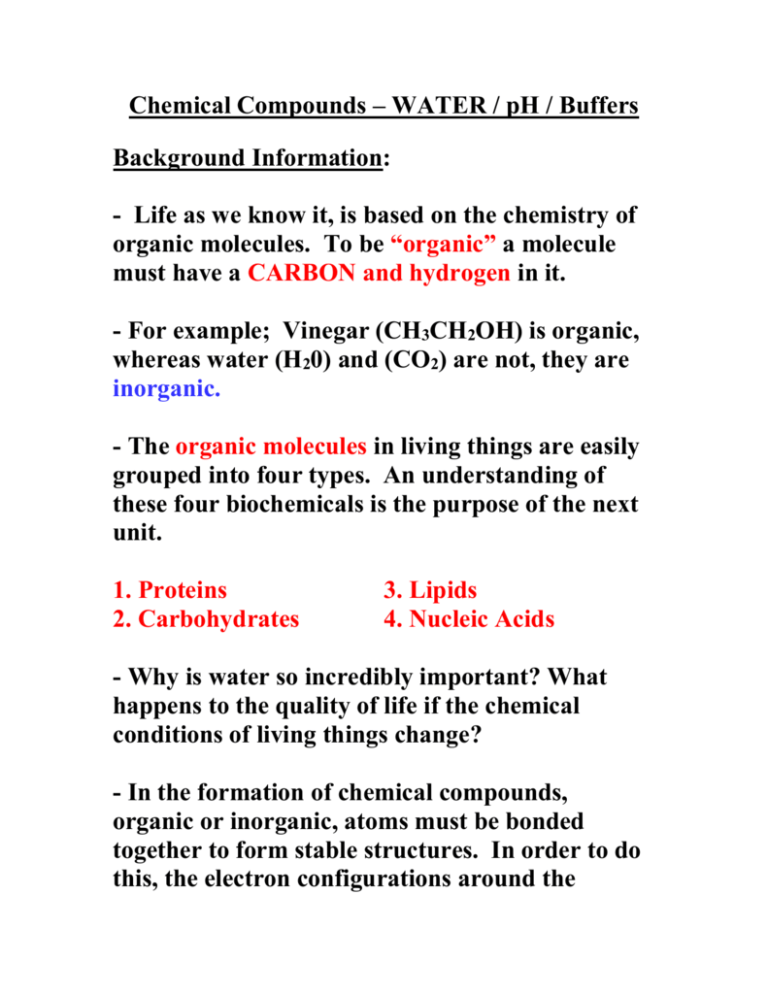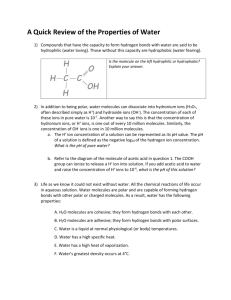Unit B- Cell Compounds (2 - Mr. Lesiuk
advertisement

Chemical Compounds – WATER / pH / Buffers Background Information: - Life as we know it, is based on the chemistry of organic molecules. To be “organic” a molecule must have a CARBON and hydrogen in it. - For example; Vinegar (CH3CH2OH) is organic, whereas water (H20) and (CO2) are not, they are inorganic. - The organic molecules in living things are easily grouped into four types. An understanding of these four biochemicals is the purpose of the next unit. 1. Proteins 2. Carbohydrates 3. Lipids 4. Nucleic Acids - Why is water so incredibly important? What happens to the quality of life if the chemical conditions of living things change? - In the formation of chemical compounds, organic or inorganic, atoms must be bonded together to form stable structures. In order to do this, the electron configurations around the various nuclei in the compound must also be stable. The stability can be achieved through some degree of sharing electrons between the atoms. - If the atoms share the electrons reasonably equally, their association is termed covalent bond. - The alternative is a very unequal sharing. This is called Ionic bonding. Where it seems as though one atom actually gives away its electrons. Neutral atoms become positive ions when they lose electrons. - In between these two extremes is what is termed polar covalent. Polar covalent molecules have dipoles ( regions with slight positive and negative natures ). The water molecule is an example of this kind of molecule. Water Structure of water: In a covalent bond atoms share electrons to become stable. In water, each hydrogen shares a pair of electrons with oxygen. The oxygen atom is much larger and tends to attract the shared electrons more. Therefore, oxygen has a partial negative charge while each hydrogen has a partial positive charge. - Any molecule that ends with a different charge is called a polar molecule. Hence it would be a dipole. - One end being the negative dipole and the other being the positive dipole. - This means that water molecules are loosely attracted to one another. The negative charge on the oxygen of one molecule is attracted to the positively charged hydrogen on another water molecule to produce a weak bond called a Hydrogen Bond. Therefore, water tends to clump together. Although the bond is weak, the vast number of these bonds gives water its unique properties. Roles of Water 1) Water acts as a solvent (The “Universal Solvent”) and is able to dissolve many chemical substances especially other polar molecules such as salts. - Since blood is mainly water, the ability of water to dissolve and transport substances greatly aids in bringing about necessary chemical reactions in the body. 2) Moderates Climate (both internal and external climates) due to its high Specific Heat Capacity. - Water can absorb a great deal of heat while only rising in temperature a slight amount due to the H-bonding. It also releases heat slowly. Example: Oceans keep surrounding land masses cool in summer and warmer in winter. Example: Body systems are mainly water, therefore, bodies tend to stay at relatively constant temperatures despite external conditions. 3) Liquid water is more dense than ice. (very rare for compounds). - Therefore, ice forms on top of water, insulating lower levels. This allows living things to function under the ice surface. Hydrogen bonding allows molecules to come closer together. If ice formed at the bottom, all lakes and oceans would freeze solid in the winter. 4) Water is transparent. - Allows light to penetrate well into water bodies to the organisms below. This allows photosynthesis to take place in aquatic environments 5) Water molecules are cohesive. They stick to each other and to other surfaces. This keeps surfaces moist and lubricated. - Diffusion of gases occurs much more efficiently across moist surfaces. Acids, Bases and Buffers Acids : are molecules that dissociate to release hydrogen ions (H+). HCl (hydrochloric acid) is a strong acid because it dissociates to free up many many H+ ions. - Systems with HCl in them have a lot of free H+ (Hydrogen ions) floating around. Bases : are molecules that release Hydroxide ions (OH-). Molecules like NaOH are bases. Bases have a neutralizing effect on acids because the H+ ions will combine with OH- ions from a base and form water and a salt. At pH 7, the concentration of hydrogen ions = the concentration of hydroxide ions. [ H+ ] = [ OH- ] - At pH 6, there are 10 times more H+ than at pH 7 - pH 3 has 100 times more H+ than pH 5 - The pH scale is just a comparison between the [ H+ ] and [ OH- ]. - pH under 7 is acidic. - pH = 7 is neutral. - pH over 7 is basic. Most enzymes (organic catalysts), which control the chemical reactions in your body, can only operate at certain pH levels. Example: Blood must be at pH 7.4 or else we become ill. The blood cannot transport O2 + CO2 efficiently if blood pH is off. Buffers : are chemicals or a combination of chemicals that are able to keep pH levels constant. They absorb excess H+ or OH- ions from substances. Example: Bicarbonate (HCO3-) absorbs excess acid (H+ ions) Without a Buffer With a Buffer Note: The buffer keeps pH constant despite adding more and more acid. Example of Buffering System # 2 #1 H2CO3 Carbonic Acid H+ + Hydrogen Ion HCO3Bicarbonate Ion - If H+ is added, the reaction will run in the direction of arrow #2 - If OH- is getting too high, the reaction will run in the direction of arrow #1. This will release H+ ions to join to the OH- ions to form water.










